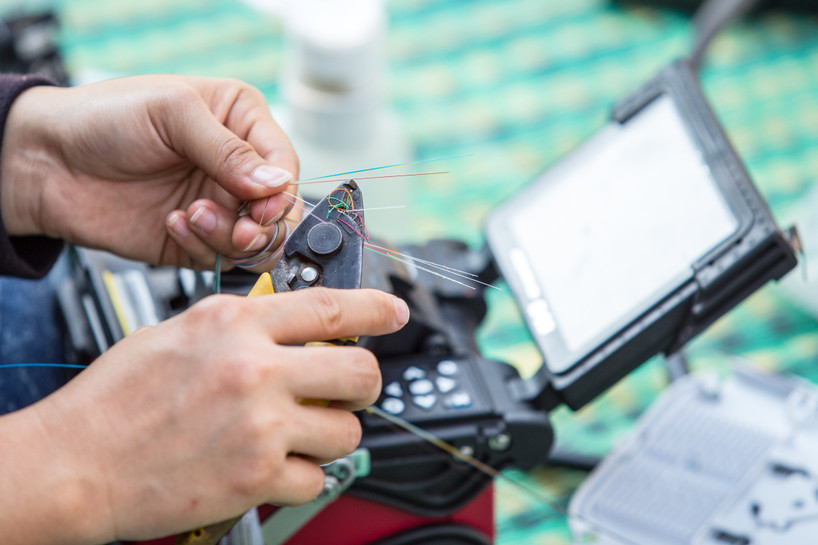Fiber optic technology forms the backbone of today’s communication networks, powering everything from high-speed internet to data centers and smart infrastructure. As the demand for faster, more reliable connectivity continues to rise, fiber optic technicians face growing pressure to deliver precise, high-quality installations. However, even seasoned professionals can make small errors that lead to costly network issues. Avoiding these mistakes is key to ensuring consistent performance and long-term reliability.
In this post, we’ll break down the five most common mistakes fiber optic technicians make and how to prevent them using the right tools and techniques.
1. Failing to Clean Fiber Connectors Properly
Dirty connectors are one of the leading causes of signal loss in fiber optic systems, and also one of the easiest problems to prevent. Even microscopic dust or oil particles can disrupt light transmission, resulting in attenuation and network instability. Many technicians skip proper cleaning due to time constraints or use incorrect methods such as wiping connectors with clothing or paper towels.
The fix: Always clean and inspect connectors before mating them. Use lint-free wipes, optical-grade cleaning fluids, and specialized tools such as the Jonard Tools FCC-300 Fiber Connector Cleaner or FW-50 Fiber Wipes for thorough cleaning. Regularly training technicians on proper cleaning techniques can dramatically reduce signal loss and extend network life.
2. Improper Fiber Splicing
Fiber splicing, whether mechanical or fusion, is one of the most critical steps in any installation. Poor splicing can result in excessive signal loss, weak joints, or even system failure. Mistakes often occur when fibers aren’t properly cleaned or cleaved before splicing, or when technicians rush through the process without following manufacturer guidelines.
Best practices:
- Use a precision fiber stripper and cleaver, such as the Jonard Tools FCT-100 Fiber Cleaver, to prepare the fiber ends.
- Follow exact splicing procedures and align fibers carefully using a calibrated fusion splicer.
- Protect completed splices with heat shrink sleeves and always verify splice integrity with an OTDR or power meter.
A clean, well-prepared splice ensures minimal signal loss and maximum performance.
3. Bending Fiber Optic Cables Too Tightly
Exceeding a fiber’s minimum bend radius is a common cause of performance degradation. Sharp bends can cause microbends or macrobends, leading to high attenuation and disrupted signal transmission. This often happens when cables are routed through tight corners, overfilled conduits, or poorly managed trays.
How to prevent it:
- Always check the manufacturer’s specified bend radius for each cable type.
- Use bend guides and cable supports to maintain smooth, controlled routing.
- Plan cable paths in advance to minimize stress and ensure longevity.
Proper cable handling helps maintain signal integrity and prevents costly service calls.
4. Incorrect Fiber Termination
Poor termination practices can cause reflection, insertion loss, or even complete connection failure. Common issues include improper fiber preparation, incorrect connector types, or inadequate polishing. When connectors aren’t properly matched or cleaned, signal transmission becomes inconsistent and unreliable.
To get it right:
- Use compatible connectors and follow the correct termination method for each type.
- Polish end faces thoroughly and test every termination using insertion loss or return loss tests.
Taking the time to properly terminate fibers ensures durable, low-loss connections across your network.
5. Neglecting Cable Management
Good cable management is often overlooked but essential for long-term network health. Disorganized cables can lead to signal interference, accidental disconnections, and increased maintenance time. Overfilled trays, poor labeling, and improper routing all contribute to system failures over time.
The solution:
- Use proper routing, labeling, and bundling techniques.
- Avoid overstuffing conduits or trays.
- Secure cables with ties or Velcro straps and use bend radius guides to maintain order.
Proper organization not only improves performance but also makes troubleshooting and maintenance faster and safer.
Setting the Standard with Jonard Tools at Georgia Underground Superstore
At Georgia Underground Superstore (GUS), we’re proud to offer a full range of Jonard Tools, trusted by fiber optic professionals worldwide for their precision, durability, and reliability. From fiber cleaning kits and splicing tools to termination and testing equipment, our inventory is designed to help you achieve flawless installations and long-lasting performance.
Browse our Fiber Optic Cable, Cable Handling and Installation Equipment here: Fiber Optic Cable, Cable Handling and Installation
Browse our full line of Jonard Tools here: Jonard Products - Georgia Underground Superstore

